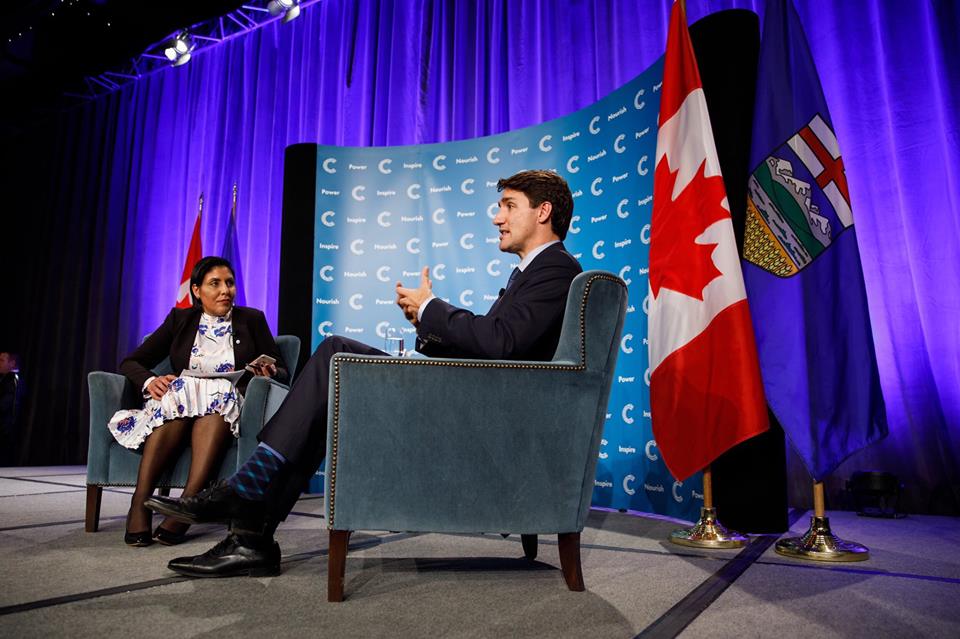
OTTAWA — “We took a one-per-cent growth rate under the Conservatives and turned it into a three-per-cent growth rate. We created 700,000 new jobs over the past three years, and right now we have the lowest unemployment rate in recorded history in Canada.” — Prime Minister Justin Trudeau
****
Prime Minister Justin Trudeau decided the end of 2018 was a good time to look back at the economic and jobs gains since he took office. “We took” low growth and sent it higher, he said. “We created 700,000 new jobs,” he added.
All of which raises a question: can the prime minister — and his government’s policies, by extension — take credit for all the economic benefits the country has felt since late 2015?
Spoiler alert: The Canadian Press Baloney Meter is a dispassionate examination of political statements culminating in a ranking of accuracy on a scale of “no baloney” to “full of baloney” (complete methodology below).
This one earns a rating of “some baloney.” Here’s why.
The facts
Canada’s economy grew at a rate of one per cent in 2015 — dropping from about 2.9 per cent in 2014 — when the Trudeau Liberals replaced the Harper Conservatives in the autumn.
The Liberals’ first budget in 2016 estimated that economic impacts of their spending would mean an increase to Canada’s gross domestic product of 1.5 per cent between 2016 and 2018, and create or maintain 143,000 jobs.
In 2016, the economy grew by 1.4 per cent. The economy got hot and grew by three per cent in 2017, and is expected to finish 2018 with further growth of around two per cent.
An analysis of Statistics Canada jobs data shows about 792,000 jobs have been created in Canada since the Liberals took office. Almost 690,000 of those jobs have been full-time, and the remaining 102,000 part-time.
The unemployment rate has dropped from 7 per cent when the Liberals took office to 5.6 per cent, the lowest mark since comparable data first became available in 1976. The country registered a 5.4-per-cent unemployment rate in 1974 under the previous statistical approach.
The experts
Former parliamentary budget officer Kevin Page said there is a case to be made that higher government spending on infrastructure and the Canada Child Benefit has boosted economic growth — modestly. The Liberals have boosted federal spending as a percentage of the economy, and the $34.3-billion increase amounts to about 0.6 per cent of gross domestic product, he said.
Iglika Ivanova, a senior economist with the B.C. branch of the Canadian Centre for Policy Alternatives, said some public spending, such as on child care to allow parents to get into the workforce, has wider effects than others, such as tax measures.
“When the government spends money, it doesn’t go into a black hole. It becomes somebody’s income and then this person then spends it,” she said. “It may overstate it to say the government is responsible for all of the economic growth, because obviously other things happen too, but they certainly played a role.”
Fraser Institute president Niels Veldhuis said federal infrastructure spending might have given a bump to the economy, but much of it may not have the same economic ripple effects that investments yielded by building or improving trade infrastructure.
Philip Cross, a senior fellow at the Macdonald-Laurier Institute, said the income-tested child benefit likely had a bigger economic effect than infrastructure spending. He said it’s not clear how much of the billions in payments was spent, which would help the economy, and how much was saved, which economists refer to as “leakage.”
The Canadian economy has also benefited from a strong global economy over the past two years, Cross said, warning there are signs that the world — and Canada — are headed for a slowdown.
“Things happen in the business sector, particularly with a global, integrated economy, that governments don’t control as much as they used to,” Cross said.
The verdict
It’s true Canada has seen boosts in the economy and jobs since 2015, but experts say no government can take full credit for all the good economic news. If that were the case, then economic downturns must also be the fault of government, they say.
Trudeau’s comments, therefore, have “some baloney” — the facts are accurate, but taking credit for everything is a step too far down the baloney road.
“In the political side, we get a lot of spin and that’s not a Liberal or Conservative or NDP (thing),” Veldhuis said. “They’re going to look at things and, in part, kind of skew them in favour of themselves and I think you’ve seen that here with a quote from the prime minister.”
Maybe this time of year will remind federal politicians to take up a New Year’s resolution have less baloney in their statements. If not, experts suggest voters look for a variety of trustworthy sources — the parliamentary budget office, for instance — to decide how accurate a politician is being about what he or she can do for the economy.
“We suspend our disbelief and believe them because it’s comforting to think that our political system controls events,” Cross said, “but I think the track record shows it really doesn’t.”
Methodology
The Baloney Meter is a project of The Canadian Press that examines the level of accuracy in statements made by politicians. Each claim is researched and assigned a rating based on the following scale:
No baloney — the statement is completely accurate
A little baloney— the statement is mostly accurate but more information is required
Some baloney — the statement is partly accurate but important details are missing
A lot of baloney — the statement is mostly inaccurate but contains elements of truth
Full of baloney — the statement is completely inaccurate